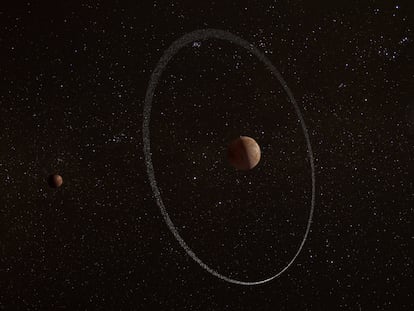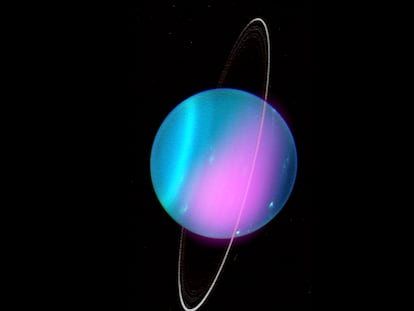NASA’s plans for the end of the ISS: private space stations and hotels with an Earth view
With nearly a quarter century of history behind it, the international space station probably won’t make it into the next decade

When the time comes to do away with the International Space Station (ISS), NASA has no plans to replace it. The agency has just declared its intention to cede future developments to private companies and reserve for itself the role of a mere user of what is known as Commercial Destinations in Low-Earth Orbit (LEO).
Ultimately it is hoped that private initiatives will establish small – or not so small – orbital laboratories, ranging from industrial facilities for the manufacturing and processing of materials to the long-dreamed of “space hotels.”
There is already a precedent. Elon Musk’s Space X has been offering its launch services for years, both to NASA and to private companies, and has even launched military payloads into orbit that are subject to serious confidentiality restrictions. Meanwhile, Blue Origin has just signed an agreement with NASA to launch a probe to Mars next year, using its brand new super rocket, New Glenn.
NASA hopes that private initiatives will establish small – or not so small – orbital laboratories, ranging from industrial facilities for the manufacturing and processing of materials to the long dreamed of “space hotels.”
In 2016, another company, known as Bigelow Aerospace, sent an inflatable module to the space station, in the shape of a three-meter diameter sphere attachable to the “Harmony” section of the ISS, the one that always faces Earth. It is still there. Bigelow ceased operations in March 2020, a victim of pandemic restrictions, and ownership of the module passed to NASA, which continues to fund maintenance.

The inflatable structures are not as fragile as they might seem. They are constructed of a fabric similar to the Kevlar material used in bulletproof vests, and their multiple layers offer a good degree of radiation protection. There are plans to use them to build small hotels for space tourists. Currently, they are attached to the ISS, but in the future, once equipped with power generation systems, they could fly independently.
NASA’s current proposal is directed at the owners of future space stations who would offer complete services, from astronaut training to their transport to orbit – both their stay and their return to Earth. They would also include management of what NASA euphemistically refers to as “mishaps,” such as responding to unforeseen failures during launches or operations in space, including NASA personnel in rescue efforts.
In its role as client, NASA estimates it could need between 3,000 and 4,000 man-hours annually, to carry out, at most, about 230 experiments. That would involve carrying about 5 tons of equipment into orbit with a volume equivalent to a small van and returning the processed materials to the ground. The agency would cover the costs, but the responsibility for operations would be that of the station owner with supervision by NASA technicians.
NASA estimates it could need between 3,000 and 4,000 man-hours annually, to carry out, at most, about 230 experiments. That would involve carrying about 5 tons of equipment into orbit with a volume equivalent to a small van
NASA specifies that the habitat must allow the astronauts to be in shirtsleeves; must be a quiet environment to facilitate sleep and relaxation; be equipped with facilities for the elimination of odors, an adequate kitchen to prepare hot meals and exercise equipment, which is essential in microgravity situations. Other details include astronauts having a toothbrush and toothpaste, there being systems for collecting physiological waste, such as nail clippings and hair; access to internet, e-mail, movies, games and digital books. They must also be provided with a private compartment to store personal items, such as photographs, jewelry and, if necessary, a guitar or a saxophone.
It is curious that NASA’s requests do not include an airlock to go outside, although they acknowledge that it would be useful if repairs need to be made outside the spacecraft, and a system is needed to expose experiments to the vacuum and retrieve them afterwards.
What lies behind these detailed requirements is that NASA is well aware of the challenges that lie ahead in the not-too-long term. The ISS is not the only space station in the world; China has its Tiangong, already completed and operational. It is much smaller in size than the ISS, being more akin to the old Russian Salyut and Mir, but is more modern and open to future expansion.
China has not yet brought astronauts from other countries to its station, although it has offered to host scientific experiments to anyone interested through the UN space agency. Some Western companies have already accepted the offer. In the future, the use of outer space may be the new arena for generating multi-billion-dollar projects.
Sign up for our weekly newsletter to get more English-language news coverage from EL PAÍS USA Edition
Tu suscripción se está usando en otro dispositivo
¿Quieres añadir otro usuario a tu suscripción?
Si continúas leyendo en este dispositivo, no se podrá leer en el otro.
FlechaTu suscripción se está usando en otro dispositivo y solo puedes acceder a EL PAÍS desde un dispositivo a la vez.
Si quieres compartir tu cuenta, cambia tu suscripción a la modalidad Premium, así podrás añadir otro usuario. Cada uno accederá con su propia cuenta de email, lo que os permitirá personalizar vuestra experiencia en EL PAÍS.
¿Tienes una suscripción de empresa? Accede aquí para contratar más cuentas.
En el caso de no saber quién está usando tu cuenta, te recomendamos cambiar tu contraseña aquí.
Si decides continuar compartiendo tu cuenta, este mensaje se mostrará en tu dispositivo y en el de la otra persona que está usando tu cuenta de forma indefinida, afectando a tu experiencia de lectura. Puedes consultar aquí los términos y condiciones de la suscripción digital.
More information
Archived In
Últimas noticias
New York enters the era of Zohran Mamdani
Welcome to the post-religion era: The idea of Christianity as the absolute truth has become obsolete
‘I thought you would like it’: The risky sexual practice popularized by TV shows and TikTok
The digitalization of tourism: ‘They promise experiences and gave us the worst possible one’
Most viewed
- Sinaloa Cartel war is taking its toll on Los Chapitos
- Reinhard Genzel, Nobel laureate in physics: ‘One-minute videos will never give you the truth’
- Oona Chaplin: ‘I told James Cameron that I was living in a treehouse and starting a permaculture project with a friend’
- Why the price of coffee has skyrocketed: from Brazilian plantations to specialty coffee houses
- Silver prices are going crazy: This is what’s fueling the rally











































